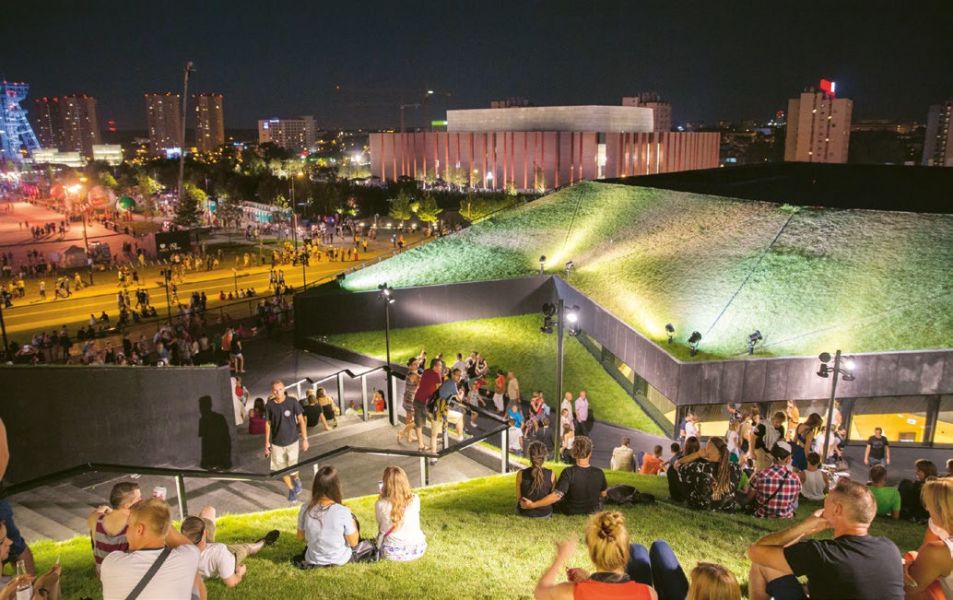Elbląg's port activities

Interview with Arkadiusz Zgliński, Director of Spółka Zarząd Portu Morskiego Elbląg
FOCUS ON Business: Mr. Director, Elbląg is an inland town, but for years it has been associated with access to the Baltic Sea via the Elbląg Bay. When was the port in Elbląg established and what were its original assumptions?
Arkadiusz Zgliński, Director of Spółka Zarząd Portu Morskiego Elbląg: The maritime traditions of Elblag date back to its oldest history, and if we consider the Prussian emporium Truso to be its predecessor, it even predates it. From the very beginning of its existence dated to 1237, Elbląg was a market town. For the first 70 years Elbląg was the only seaport and the most important centre of town-styled life of the young Teutonic country. It was one of the most important ports for the most influential Hanseatic Kontore in Novgrod. Situated on the Elblag River, the Old Town port was located 10 km from the river’s estuary to the Vistula Lagoon. The port’s first roadstead was also located here. In the 20-year period between the World Wars almost 100 merchant ships were built in Elbląg shipyards. After the First World War the port significantly declined. Then, after a few years, first inland shipping, then maritime shipping began to revive. Between 1933 and 1937 as many as 1605 ships arrived in the port, which clearly indicated a revival, but not on the scale compared to big Baltic ports. The biggest turnover in the port took place in 1936. Coal, coke, iron, fodder, building materials, fertilizers were exported through the port, while grain, flour, tobacco and machine elements were imported. In 1945 Elbląg returned to Poland. As a result of many circumstances, the town, despite attempts just after the war and in the following years, could not return to its former role as a sea port. The process of reconstruction and economic activation of maritime cities, including Elbląg was supported by Eugeniusz Kwiatkowski. On his initiative, in March 1946, an organisational meeting of the Economic Association of the Maritime Cities was held at the headquarters of the Government Delegation for Maritime Affairs in Gdańsk, at which the Act of the Organisational Committee was signed. This document emphasised that Poland was becoming a truly maritime state, gaining wide access to the sea from Szczecin, through Gdynia and Gdańsk, to Elbląg. In 1946, an attempt was made to change the decision regarding the port, the Association of Polish Ports considered its reconstruction, and in April there was serious discussion about building a canal across the Vistula Spit to connect the port with the sea, but these plans were quickly abandoned.
The seaport in Elbląg was formally established in 1947. The Ministerof Shipping, A. Rapacki, by decree of the 9th of December, 1947 on the establishment of maritime offices and harbour master’s offices, established the following: "§ 4. As a part of maritime offices, the harbour master’s offices are being established in: Gdańsk, Gdynia, Szczecin with Świnoujście, Elbląg, Hel, Władysławowo, Łeba, Ustka, Darłowo, and Kołobrzeg (...)”. Five years later, in 1952, the Minister of Shipping, M. Popieł, by his decree of the 16th of February, 1952 on the establishment of the territorial border of the seaport on the Vistula Lagoon in Elbląg, established the territorial border of this port. In 1949, the project to build a canal through the Vistula Spit was reintroduced. However, the decision of the head of the Transportation Department of the Chief Committee of the Polish United Workers' Party closed the matter. Meanwhile, in various places on the Elbląg River 40–50 thousand tons of cargo were transshipped annually. In the period of communist Polish People’s Republic, the attitude of the maritimeadministration played decisive role.
Although the Vistula Lagoon was economically unused, the Maritime Office in Gdynia carried out a number of modernization works in the administered ports in Krynica Morska, Frombork and Tolkmicko. The only serious attempt to revive the Elbląg port during the communist era was the establishment of the Council of Port Users in the mid-1960s. The town councillors initiated the formation of this body with a view not only to maritime transport, but also to the development of inland shipping.
How has the function of the port of Elbląg changed over the last few decades?
The port of Elbląg is a typical river and sea port of local character. Therefore, it handles inland passenger and cargo shipping, yachts and other sport boats, also inland and sea vessels, short-range sea shipping, possibly including ferries. Inland cargo shipping on domestic routes is currently operated between Elbląg and the ports of the Tri-City. Also passenger shipping is carried out on the Vistula Lagoon, but mainly outside Elbląg. After 2006 trans-shipments and cargo trading in the Elbląg port practically disappeared due to the banning free navigation on the Russian part of the lagoon decided unilaterally by the Russian government. It was not until 2010, after the agreement signed by the governments of Poland and Russia in 2009, that the activities of the Elbląg port were reactivated. Afterwards, trans-shipment and tourist traffic reopened to the eastern markets. The volume of trans-shipments grew year by year until the annexation of Crimea by the Russian Federation when the geopolitical conflict arose. As a result, after 2016, trans-shipments at the Elbląg port started to decline again. Moreover, the Russian Federation used instead of the sanctions imposed by the EU relevant economic tools in the form of prohibitive customs duties and the necessity of building materials to be certified by Russian institutions. As a result of such measures, the volume of trans-shipments dropped from 358 thousand tonnes in 2014 to around 100 thousand tonnes per year by 2020.
The construction of a waterway through the Vistula Spit has been widely discussed for several years. What benefits will the canal bring to Elbląg and what infrastructural changes in the port will it entail?
As a member of the EU, Poland is a very important point of contact between the Union and the former Eastern Bloc countries. The lack of access to the open sea on the Polish side of the Vistula Lagoon makes this water body the only one of its kind in Europe, which means that the coastal municipalities cannot fully use its development potential in the social and economic terms provided by the Baltic Europe. The construction of the canal, which is part of the waterway between the Elbląg seaport – the Vistula Lagoon – the Bay of Gdańsk, determines not only the proper use of the newly built reloading terminal in the Elbląg port, but also the development of municipalities located on the western and southern sides of the Vistula Lagoon. In addition, this canal will allow the opening of the Vistula Lagoon for the European Union member states. The fundamental results to be achieved due to the construction of the Shipping Canal through the Vistula Spit include: a direct connection of the Vistula Lagoon to the sea within the Polish borders, making Elbląg Sea Port available for sea vessels, reaching at least 3.5 million tonnes of annual trans-shipping volume in the Elbląg Sea Port, i.e. at least 3 million tonnes more than without the construction of the canal, shortening of the sea routes between Elbląg and Tri-City, Elbląg – ports of Western Europe and Elbląg – ports of the eastern Baltic, making the Vistula Lagoon and the marinas located on it available for yachts from the sea. Moreover, the possibility of sailing a tourist ship from the Vistula Lagoon to the sea will make tourist stay at the Lagoon more attractive, tourist attractions in the area of the Vistula Lagoon (Elbląg, Frombork) for coastal tourist ships from the sea will become available and the time of tourist cruises from Tri-City to Elbląg, Frombork and Krynica Morska will shorten. Finally, the expansion of commercial cooperation with ports of the Kaliningrad Region will be possible. The Shipping Canal through Vistula Spit designed and built in this way will become an important connection within the international waterway system, connecting the Baltic Sea with the sea port in Elbląg and other ports on the Vistula Lagoon.
Looking from a business perspective, it is important to have port-related logistics. Please share the most important technical data related to the port facilities.
Elbląg, constantly thinking of future open access to the Baltic Sea, thanks to the favourable attitude of local authorities, has made a number of investments in infrastructure and access to the port. The total investment expenditures exceeded PLN 100 million. The most important investments included: construction of the European Union Route, a storage and trans-shipment terminal, a passenger terminal with an international customs clearance point, modernisation and extension of the Elbląg Sea Port infrastructure (within the Old Town area), the Żuławy Loop, modernisation of the hangar for sailors at the Yacht Club at Radomska Street.
Business is one thing and passenger traffic is another. What are the current and future plans with regard to passenger service and the directions of cruises from the port of Elbląg?
As mentioned above, the Elbląg port has a passenger and ferry terminal with an international passenger and car customs clearance point, which meets all customs and border clearance requirements. Moreover, the terminal has a 198- meter long mooring wharf and a ro-ro ramp for ferry boats. Another important area adapted for mooring passenger vessels as well as yachts and motor boats is the modernised mooring wharf located in the centre of the Old Town. Additionally, in the Elbląg port there are marinas and tourist harbours with complete infrastructure. After the canal is built, sailing directions could be ports in Tri-City, Scandinavia and other western Europe ports, as well as to ports in the Kaliningrad Region, if the relationship with Russia sufficiently improve. Still, as much important will be shipping to ports located on the Lagoon, inland shipping along the Żuławy Loop and the Elbląg Canal route via slipways that are unique in the world.
Finally, let us return to the port area itself. Do you currently have any land available for tenants to use and, if so, what is it and what is it for?
Of course, both the company and the city have land resources dedicated to port development, construction of new terminals, storage yards or warehouses. Already this year, we have leased an area of over 0.5 hectare adjacent to the current trans-shipment terminal, intended for storage and warehousing of goods. In addition, we have acquired a new over 150-metre long quay with access to a railway siding, which is currently being modernised by a new business operator. Further on, advanced negotiations are being held with the Mayor of Elbląg on the sale or lease of a 5 ha area adjacent to the Elbląg River to a prospect investor. Other land reserves include plots of over 20 ha located in the north-eastern part of the town. Also land located directly by the river is dedicated for activities that require and support water transport.
Thank you for the interview.









